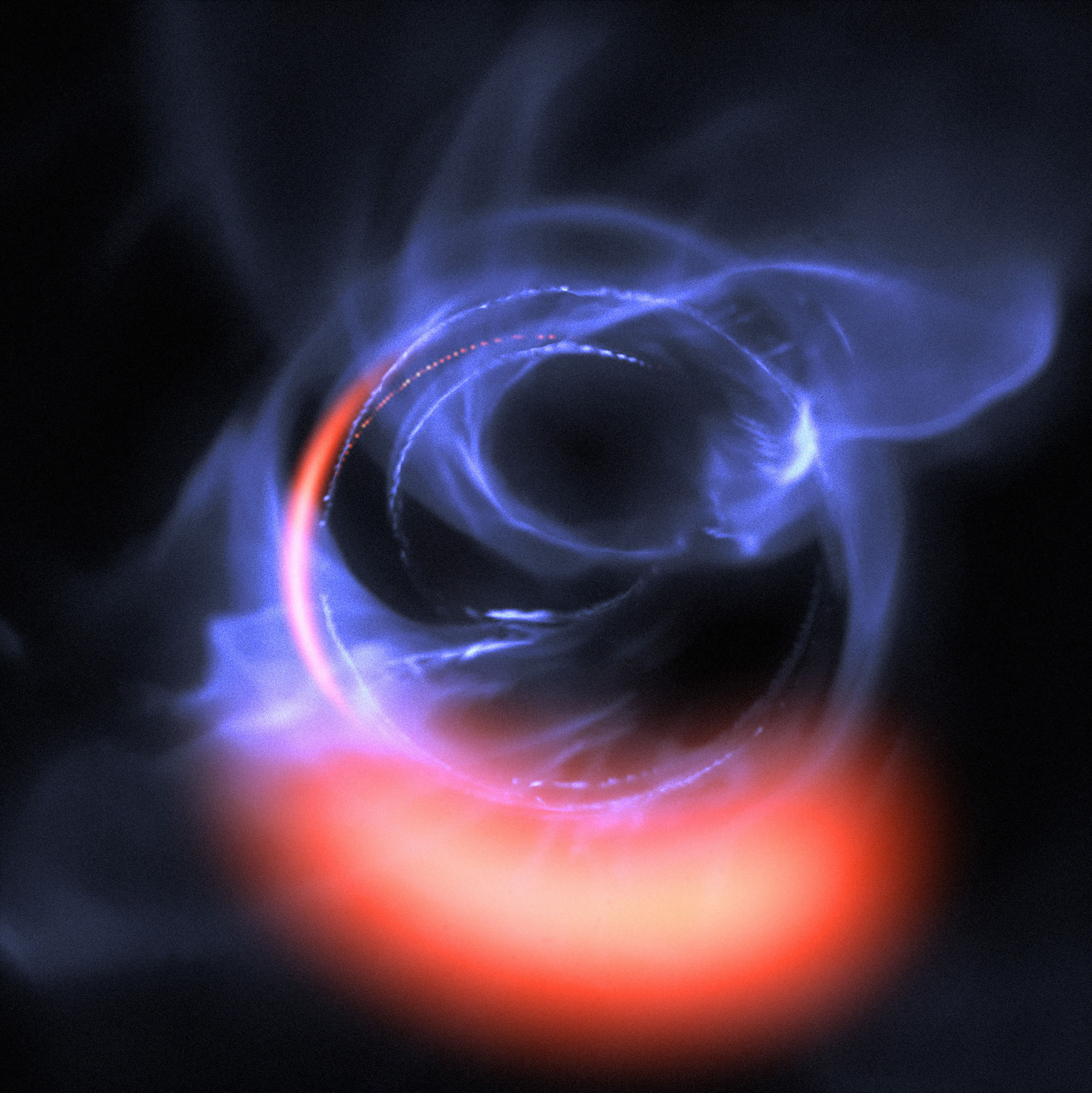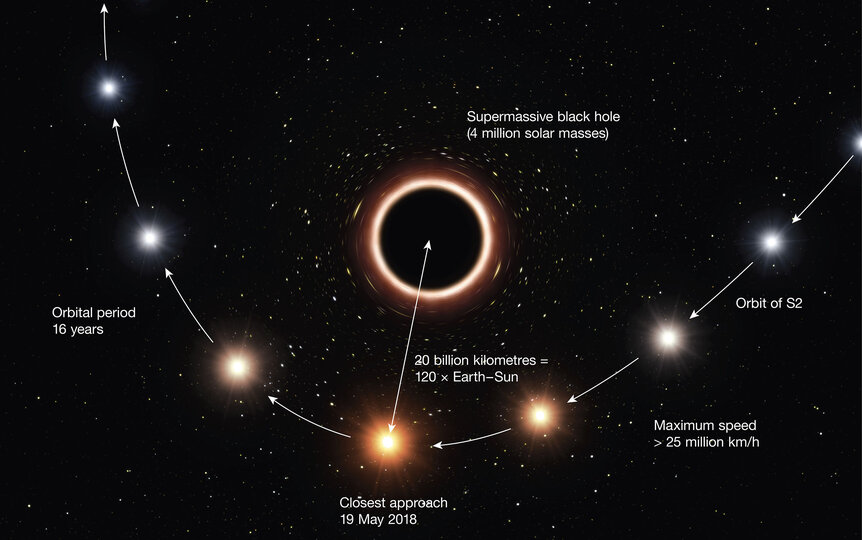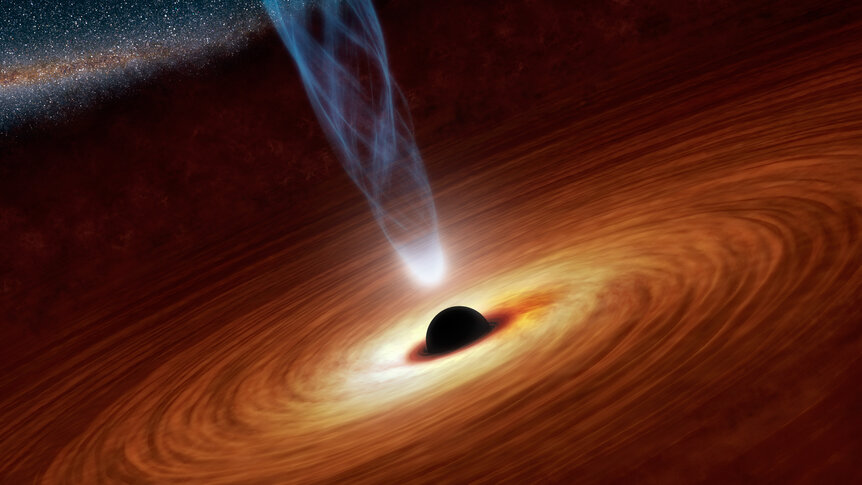Create a free profile to get unlimited access to exclusive videos, sweepstakes, and more!
Astronomers see material orbiting a black hole *right* at the edge of forever

I read quite a few scientific journal papers every week, seeing which ones might make a good fit for the blog. They’re always interesting, and of course some have more ground-breaking results than others. But you can count on the fingers of one hand how many times one has made me exclaim out loud upon reading it.
I just read one where I exclaimed out loud.
In fact, I may have exclaimed an expletive out loud — “holy [synonym of feces]!” — when I read the abstract of this particular paper.
Why? Because in the paper, a team of astronomers show that they have observed a blob of dust sitting just outside the point of no return of a supermassive black hole, where the gravity is so intense that this material is moving at thirty percent the speed of light. And this wasn’t inferred, deduced, or shown indirectly. No: They measured this motion by literally seeing the blobs move in their observations.
Holy [synonym of feces].
To explain what’s going on, I need you to come along with me on a journey. It’s a bit of a haul — 26,700 light years — but it’s worth it.
At the heart of our galaxy lies a monster.
Sitting in the exact center of the Milky Way is a supermassive black hole… and astronomers don’t use that adjective lightly. It has a mass over 4 million times that of the Sun, and all of that is squeezed down into a spherical region of space only 20 million kilometers across. The Sun itself is over a million kilometers across, so this is a tiny volume for all that mass. The gravity of such a beast is so immense that if you get too close, you cannot escape. Not even light, which travels at the fastest possible speed in the Universe, can get out. It’s like a dark extremely massive infinitely deep hole.
So: a supermassive black hole.
We’re pretty sure that one of these beasts is at the center of every large galaxy in the Universe, and may even be tied to their host galaxy’s formation and evolution. We see plenty of evidence of them… including in our own galaxy. Quite a few stars have been seen very close to the center of the Milky Way, and some of them are orbiting something there. Their motions can be directly seen, and one, called S2, circles the center on an orbit just 16 years long, taking it to within a breathtaking 18 billion kilometers of the exact center.
Using Kepler’s laws of motion, the shapes and periods of the stars’ orbits can be used to find the mass of the object they orbit, and that’s where the 4 million solar mass figure comes from. Yet we see nothing emitting light there, no huge object, no star cluster. It really must be a black hole. Anything else would be extremely bright.
The black hole, called Sgr A* (usually pronounced “Saj Ay star,” short for “Sagittarius A star”), has not only stars orbiting it, but a small amount of gas and dust as well. Some galaxies have a lot of this material, so much that it flattens into a disk, heats up hugely due to friction (the stuff closer to the black hole orbits a lot faster than stuff farther out, generating a lot of rubbing), and glows so brightly that ironically they become the brightest continuous sources of light in the Universe — active galaxies like quasars and blazars. Happily, our black hole is on a more meager diet.
But there is stuff there around Sgr A*. We know because we still see some light coming from outside the black hole, just not much. But we can study this light carefully and learn about the dark master controlling its behavior.
And this brings us to the new observations. The astronomers used an incredibly precise instrument called GRAVITY, which combines the light from the four main telescopes of the enormous Very Large Telescope in Chile. Each individual ‘scope has an immense 8.2-meter mirror, and all four can be combined into what’s called an interferometer, giving it the ability to see details in astronomical objects as if it were a single telescope 25 times larger yet.
Over the spring and summer of 2018 they pointed this instrument at Sgr A*. In May, and then twice in July, they saw flares, sudden increases in brightness, coming from the black hole. These flares were in the infrared, meaning they probably came from warm dust orbiting the black hole (warm dust emits infrared light). It’s thought that there is a magnetic field embedded in that stuff as it swirls around the black hole, too. As the material moves around, the field lines get tangled up and then suddenly snap, releasing a lot of energy all at once. This is pretty much how solar flares work. In this case, a flare outside the black hole can get so bright it can outshine whole stars! The event lasts maybe 15 minutes before everything cools off again, the flare fades, and the process starts up once more.
This stuff is happening pretty close to the Point of No Return over the black hole. But just how close?
And this where I exclaimed out loud. Taking observations every few minutes, they could physically see the source of this infrared light moving around the black hole! They were able to get enough observations of each flare to trace the orbit of the emitting dust blob more than halfway around the black hole.
By measuring the positions over time, they found some amazing things. And by amazing, I mean exclaim-out-loud things. Each of the three flares observed moved in a way that could be fit by a single orbit, meaning they may have been seeing the same blob of gas three different times (or it may have been three blobs all on the same orbit). The orbit is highly tipped, and we see it very nearly face-on. The size of the orbit is hard to pin down exactly, but is about only 6-10 times the size of the black hole itself! That means this blob (or blobs) orbits the Sgr A* closer than Venus orbits the Sun.
At that distance — less than 100 million kilometers — they are so close that the gravity from the black hole is INTENSE: They orbit at 30% the speed of light.
30 percent. That’s 90,000 kilometers per second. Over 300 million kilometers per hour.
That’s hard to fathom. They could travel from the Earth to the Moon in a few seconds. It took the Apollo missions over three days to get that far. Or put another way: It takes Venus over 5,600 hours to orbit the Sun once. At roughly the same distance, these blobs orbit the black hole in one. One hour. One.
I was pleased to read that the astronomers were able to measure the polarization of the light from the dust, and it too changed on roughly the same period as the orbital motion. Polarization is a funny property of light where, essentially, the light waves line up a certain way (I have a more detailed but hopefully still easy-to-understand description of polarization in another post). Light bouncing off dust grains can become polarized, especially if the grains are aligned in some way… and dust grains in a magnetic field will indeed tend to align themselves with that field (as iron filings do if you hold a magnet under them).
So, as the dust orbits the black hole, the orientation of the dust grains changes, which in turn changes the polarization. That’s just what the astronomers saw, making me feel more confident they were in fact catching clouds of dust moving around the black hole.
At a third the speed of light. Holy wow.
But wait! There’s more coolness!
Black holes, like any object with mass, bend the fabric of spacetime. The thing about black holes is that they bend it a lot. So much so that the normal rules we know and love don’t apply, and things get very weird. Like, General Relativity weird.
For example, unlike normal objects like asteroids and planets and stars, there is a minimum distance from a black hole where a small object can orbit it without falling in. Farther out and you’re fine; you can orbit forever. Closer in, and space is bent so much that down you go. Because of this, something like a disk of shredded clouds of gas and dust has an inner edge, because anything that finds itself closer than that to the black hole inexorably falls in. This edge is called the innermost stable circular orbit, and its size depends on the mass of the black hole and how it spins.
If Sgr A* does not spin rapidly (the general assumption), then these dust clouds are just outside this minimum distance. That’s interesting! It implies this stuff probably does fall in after some time, which in turn implies there’s more stuff feeding it from the outside (like a faucet filling a sink at the same rate the water slides down the drain). Hopefully we’ll be able to use even more powerful telescopes to probe this infalling matter in the near future; a project called the Event Horizon Telescope, using observatories across the world, is planning to do just that very soon.
And in a broader sense, these observations from GRAVITY are important because they show that the object Sgr A* is indeed a black hole. We infer its existence, and the evidence is strong, but the direct measurements of the velocities of these ridiculously screaming fast blobs of dust show that only the immense and inexorable pull from a supermassive black hole can be pulling those strings. It’s there. It’s real.
And we can study it. Up very, very close.





























